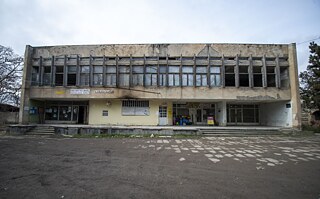Gori
The physical mapping process for the municipality included both theoretical and practical aspects for two months. Experts, along with the educational component of the developed mapping methodology, mentored the municipality’s working group through each step of the process.
A detailed list of buildings and spaces was created. To collect information about these objects, research was conducted through inter-sectoral cooperation, fieldwork, and photofilming. The gathered data was then analyzed and recorded on a digital map, and the results were presented.
A detailed list of buildings and spaces was created. To collect information about these objects, research was conducted through inter-sectoral cooperation, fieldwork, and photofilming. The gathered data was then analyzed and recorded on a digital map, and the results were presented.
Physical Mapping Results
In the municipality of Gori 26% of the 50 mapped buildings are culture and creative industry facilities, while 16% is industrial infrastructure. Retail facilities and educational indstitutions account each for 14%, administrative and hospitality buildings comprise 10% each. Sports facilities represent 2% of the total.
The usage of listed properties follows as 14% in active use, 28% partially utilized, and 58% as nonfunctional.
Of the mapped buildings, 18% are structurally stable, 60% are lightly damaged, and 23% are severely damaged.
36% of these properties are municipally owned, 46% are privately owned, and 8% are state-owned.
Notable buildings include Gori Department store, Oil pipeline factory, Tourist base, Khidistavi Club, Kvakhvreli Club, Mejvriskhevi chicken farm, Zert culture center, Mejvriskhevi Club, Mejvriskhevi culture center, Zert warehouses, Dzevera Club, Kitsnisi former club and the so-called “Kantora”, Tkviavi Club, Mereti - Village Club, Administration building and kindergarten.
The usage of listed properties follows as 14% in active use, 28% partially utilized, and 58% as nonfunctional.
Of the mapped buildings, 18% are structurally stable, 60% are lightly damaged, and 23% are severely damaged.
36% of these properties are municipally owned, 46% are privately owned, and 8% are state-owned.
Notable buildings include Gori Department store, Oil pipeline factory, Tourist base, Khidistavi Club, Kvakhvreli Club, Mejvriskhevi chicken farm, Zert culture center, Mejvriskhevi Club, Mejvriskhevi culture center, Zert warehouses, Dzevera Club, Kitsnisi former club and the so-called “Kantora”, Tkviavi Club, Mereti - Village Club, Administration building and kindergarten.






